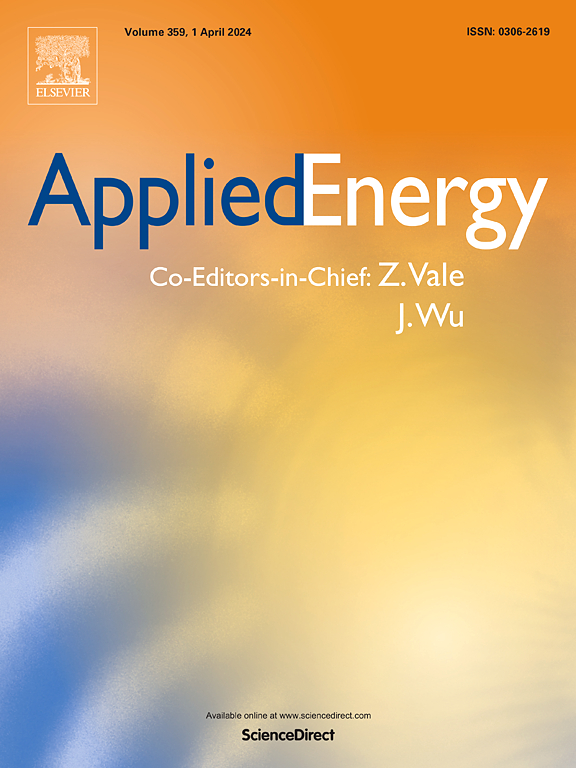混合动力有机朗肯蒸汽压缩冷却系统的实验验证
IF 10.1
1区 工程技术
Q1 ENERGY & FUELS
引用次数: 0
摘要
热激活冷却器,如吸收式冷却器和有机朗肯蒸汽压缩(ORVC)系统,为提高加热,通风和空调(HVAC)应用的效率和减少排放提供了有前途的解决方案。然而,由于可变热输入的性能挑战,它们在美国的采用受到限制。将电输入集成到ORVC系统中已被提出作为可变热输入性能下降的解决方案,但该概念尚未得到实验验证。本研究展示了263千瓦时混合ORVC测试设备在暖通空调相关条件下运行的电、热、混合冷却模式的结果。在混合冷却模式下,蒸汽压缩循环中的压缩由电动压缩机和热驱动压缩机提供。评估了三种配置:并联压缩机、先采用热驱动压缩机的串联压缩机和先采用电动压缩机的串联压缩机。最佳配置(热驱动压缩机首次串联)在热输入范围从全热到全电操作中进行了测试。测试的冷却功率为175 kW,热输入温度为91°C,散热温度为30°C,冷却温度为9°C。在低热量输入(113 kW)时,系统实现了高热COP(1.02)和低电COP(3.80),而在高热量输入(331 kW)时,热COP为0.54,电COP为8.76。性能超过纯热(COPth = 0.42)和纯电(COPth = 4.55)模式,热输入超过180千瓦。涡轮机械分析确定了压缩机的局限性,表明优化选择可以进一步提高效率。本研究建立了混合ORVC在暖通空调应用中的性能。本文章由计算机程序翻译,如有差异,请以英文原文为准。

Experimental validation of a hybrid electric organic Rankine vapor compression cooling system
Thermally activated chillers, such as absorption chillers and Organic Rankine Vapor Compression (ORVC) systems, offer promising solutions for improving efficiency and reducing emissions in heating, ventilation, and air conditioning (HVAC) applications. However, their adoption in the U.S. has been limited due to performance challenges with variable heat input. Integrating electric input into ORVC systems has been proposed as a solution to variable heat input performance degradation, but the concept has not experimentally validated. This study presents results from a 263 kWth hybrid ORVC test facility operating in electric, thermal, and hybrid cooling modes under HVAC-relevant conditions. In hybrid cooling mode, compression in the vapor compression cycle was provided by an electric compressor and a thermally driven compressor. Three configurations were evaluated: parallel compressors, series compressors with the thermally driven compressor first, and series compressors with the electric compressor first. The optimal configuration (thermally driven compressor first in series) was tested with heat inputs ranging from fully thermal to fully electric operation. Testing was conducted with cooling duty at 175 kW, heat input at 91 °C, heat rejection at 30 °C, and cooling delivered at 9 °C. At low heat input (113 kW), the system achieved high thermal COP (1.02) and low electric COP (3.80), while at high heat input, the thermal COP was 0.54 and the electric COP was 8.76 at 331 kW. Performance surpassed purely thermal (COPth = 0.42) and purely electric (COPe = 4.55) modes with heat input above 180 kW. Turbomachinery analysis identified compressor limitations, suggesting optimized selection could further enhance efficiency. This study establishes hybrid ORVC performance for HVAC applications.
求助全文
通过发布文献求助,成功后即可免费获取论文全文。
去求助
来源期刊

Applied Energy
工程技术-工程:化工
CiteScore
21.20
自引率
10.70%
发文量
1830
审稿时长
41 days
期刊介绍:
Applied Energy serves as a platform for sharing innovations, research, development, and demonstrations in energy conversion, conservation, and sustainable energy systems. The journal covers topics such as optimal energy resource use, environmental pollutant mitigation, and energy process analysis. It welcomes original papers, review articles, technical notes, and letters to the editor. Authors are encouraged to submit manuscripts that bridge the gap between research, development, and implementation. The journal addresses a wide spectrum of topics, including fossil and renewable energy technologies, energy economics, and environmental impacts. Applied Energy also explores modeling and forecasting, conservation strategies, and the social and economic implications of energy policies, including climate change mitigation. It is complemented by the open-access journal Advances in Applied Energy.
 求助内容:
求助内容: 应助结果提醒方式:
应助结果提醒方式:


